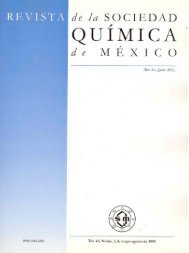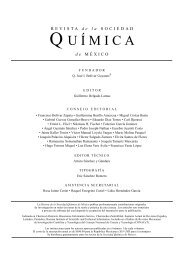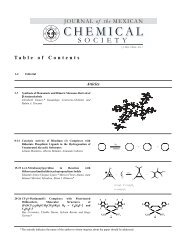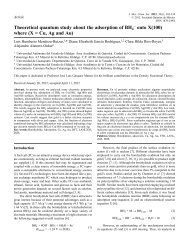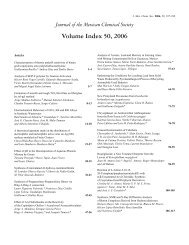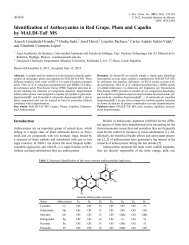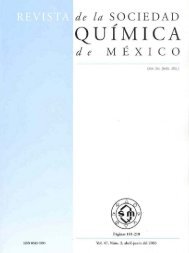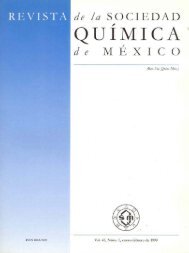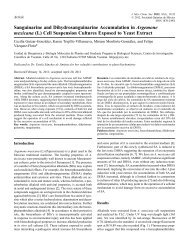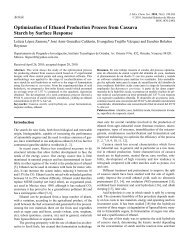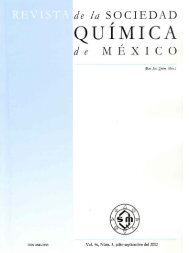Synthesis of Methyl-2[N-subtituted-N-(2-hydroxyethyl)]amino-2
Synthesis of Methyl-2[N-subtituted-N-(2-hydroxyethyl)]amino-2
Synthesis of Methyl-2[N-subtituted-N-(2-hydroxyethyl)]amino-2
Create successful ePaper yourself
Turn your PDF publications into a flip-book with our unique Google optimized e-Paper software.
Article<br />
<strong>Synthesis</strong> <strong>of</strong> <strong>Methyl</strong>-2[N-<strong>subtituted</strong>-N-(2-<strong>hydroxyethyl</strong>)]<strong>amino</strong>-2-<br />
hydroxyacetates and 2-Hydroxy-4-alkylperhydro-1,4-oxazin-3-ones<br />
Teresa Mancilla Percino* and Teresita Rocío Cruz Hernández<br />
Departamento de Química, Centro de Investigación y de Estudios Avanzados del Instituto Politécnico Nacional, Apdo. Postal 14-<br />
740, 07000 México, D. F., México. tmancill@cinvestav.mx<br />
Recibido 7 de agosto de 2007; aceptado el 20 de octubre de 2007<br />
J. Mex. Chem. Soc. 2007, 51(4), 185-192<br />
© 2007, Sociedad Química de México<br />
ISSN 1870-249X<br />
Abstract. This work describes the study <strong>of</strong> the reaction <strong>of</strong> methyl<br />
2-hydroxy-2-methoxy acetate (1) with the b-<strong>amino</strong> alcohols, N-<br />
methylethanolamine (2), N-benzylethanolamine (3), (1R,2S)-(-)-<br />
ephedrine (4) and (1S,2S)-(+)-pseudoephedrine (5) in the presence<br />
<strong>of</strong> a mixture <strong>of</strong> benzene/ethanol and formic acid, and also without<br />
solvent. In the first case the reaction led to the new acyclic compounds<br />
methyl-2-[N-methyl-N-(2-<strong>hydroxyethyl</strong>)]<strong>amino</strong>-2-hydroxyacetate<br />
(2a), methyl-2[N-benzyl-N-(2-<strong>hydroxyethyl</strong>)]<strong>amino</strong>-2-hydroxyactetate<br />
(3a), methyl-2{N-methyl-N-[(2R,1S)-2-phenyl-1-methyl-2-<br />
<strong>hydroxyethyl</strong>]}<strong>amino</strong>-2-hydroxyacetates (4a, 4a’) and methyl-2{N-<br />
methyl-N-[(2S,1S)-2-phenyl-1-methyl-2-<strong>hydroxyethyl</strong>]}<strong>amino</strong>-2-<br />
hydroxyacetates (5a, 5a’). The reaction without solvent led to cyclic<br />
compounds 2-hydroxy-4-methylperhydro-1,4-oxazin-3-ones (2b),<br />
2-hydroxy-4-benzylperhydro-1,4-oxazin-3-one (3b), (2S,5S,6R)-2-<br />
hydroxy-4,5-dimethyl-6-phenylperhydro-1,4-oxazin-3-one (4b) and<br />
(2S,5S,6S)-2-hydroxy-4,5-dimethyl-6-phenylperhydro-1,4-oxazin-3-<br />
one (5b), which we have been reported before, except 3b. The whole<br />
compounds were characterized by 1 H, 13 C, 15 N (acyclic compounds)<br />
NMR, HETCOR, infrared and mass spectrometry. Determination<br />
<strong>of</strong> minimum energy <strong>of</strong> the preferred conformation was achieved for<br />
compounds 4a, 4a’, 5a and 5a’ by theoretical calculation. The structures<br />
<strong>of</strong> 3b and 5b were further established by a single-crystal X-ray<br />
diffraction.<br />
Key words: 2-(N-<strong>hydroxyethyl</strong><strong>amino</strong>)hydroxyacetates, Oxazin-<br />
3-ones, Morpholin-3-ones, b-<strong>amino</strong>alcohols, Spectroscopy, X-ray.<br />
Introduction<br />
b-<strong>amino</strong>alcohols are an important class <strong>of</strong> compounds useful<br />
in the synthesis <strong>of</strong> a variety <strong>of</strong> acyclic and cyclic derivatives<br />
[1-15], likewise some <strong>of</strong> them and their heterocycles derivatives<br />
are used as chiral auxiliaries in asymmetric organic synthesis<br />
[16,17]. Many b-<strong>amino</strong>alcohol derivatives have been<br />
utilized in a variety <strong>of</strong> applications, for instance, in cosmetic<br />
emulsions, creams, sun protection [18] and also they have<br />
exhibited biological properties as analgesic, amebacidal and<br />
anticonvulsant [1,18-22].<br />
Because <strong>of</strong> our current interest on the syntheses <strong>of</strong> b-<strong>amino</strong>alcohol<br />
derivatives prompted us to study the reaction <strong>of</strong><br />
methyl 2-hydroxy-2-methoxyacetate (1) with N-methylethanolamine<br />
(2), N-benzylethanolamine (3), (1R,2S)-(-)-ephedrine<br />
(4) and (1S,2S)-(+)-pseudoephedrine (5) in the presence and<br />
the absence <strong>of</strong> solvents [12,13].<br />
This article describes the synthesis <strong>of</strong> new methyl-2[N<strong>subtituted</strong>-N-(2-<strong>hydroxyethyl</strong>)]<strong>amino</strong>-2-hydroxyacetates<br />
(2-<br />
Resumen. En este trabajo se describe el estudio de la reacción del<br />
2-hidroxi-2-metoxiacetato de metilo (1) con los b-<strong>amino</strong> alcoholes:<br />
N-metiletanolamina (2), N-benciletanolamina (3), (1R,2S)-(-)-efedrina<br />
(4) y (1S,2S)-(+)-pseudoefedrina (5) en presencia de la mezcla<br />
de benceno/etanol y ácido fórmico, y también sin disolvente. En<br />
el primer caso la reacción conduce a los nuevos compuestos acíclicos<br />
metil-2-[N-metil-N-(2-hidroxietil)]<strong>amino</strong>-2-hidroxiacetato<br />
(2a), metil-2[N-bencil-N-(2-hidroxietil)]<strong>amino</strong>-2-hidroxiacetato (3a),<br />
metil-2{N-metil-N-[(2R,1S)-2-fenil-1-metil-2-hidroxietil]}<strong>amino</strong>-<br />
2-hidroxiacetatos (4a, 4a’) y metil-2{N-metil-N-[(2S,1S)-2-fenil-1-<br />
metil-2-hidroxietil]}<strong>amino</strong>-2-hidroxiacetatos (5a, 5a’). La reacción<br />
sin disolvente conduce a los compuestos cíclicos 2-hidroxi-4-metilperhidro-1,4-oxazin-3-onas<br />
(2b), 2-hidroxi-4-bencilperhidro-1,4-oxazin-3-ona<br />
(3b), (2S,5S,6R)-2-hidroxi-4,5-dimetil-6-fenilperhidro-1,4-<br />
oxazin-3-ona (4b) y (2S,5S,6S)-2-hidroxi-4,5-dimetil-6-fenilperhidro-<br />
1,4-oxazin-3-ona (5b), los cuales han sido reportados por nosotros<br />
anteriormente, excepto 3b. Todos los compuestos fueron caracterizados<br />
por RMN de 1 H, 13 C y 15 N (compuestos acíclicos), HETCOR,<br />
infrarrojo y espectrometría de masas. Además, se llevó a cabo la<br />
determinación de la energía mínima de la conformación preferida<br />
de los compuestos 4a, 4a’, 5a y 5a’ a partir de cálculos teóricos. Las<br />
estructuras de 3b y 5b fueron además establecidas por difracción de<br />
rayos-X.<br />
Palabras clave: 2-(N-hidroxietil<strong>amino</strong>)hidroxiacetates, Oxazin-3-<br />
onas, Morfolin-3-onas, b-Aminoalcoholes, Espectroscopia, Rayos-X.<br />
5)a (Scheme 1) and 2-hydroxy-4-alkylperhydro-1,4-oxazin-<br />
3-ones (2-5)b and 2b’(Scheme 2). The characterization <strong>of</strong> the<br />
compounds was carried out by spectroscopic methods and the<br />
preferred conformation <strong>of</strong> diasteromers 4a, 4a’, 5a and 5a’<br />
was obtained by theoretical calculations, moreover, the structures<br />
<strong>of</strong> 3b and 5b were further established by a single-crystal<br />
X-ray diffraction.<br />
Scheme 1. <strong>Synthesis</strong> <strong>of</strong> methyl-2[N-<strong>subtituted</strong>-N-(2-<strong>hydroxyethyl</strong>)]<br />
<strong>amino</strong>-2-hydroxyacetates (2-5)a.
186 J. Mex. Chem. Soc. 2007, 51(4) Teresa Mancilla Percino and Teresita Rocío Cruz Hernández<br />
Scheme 2. 2-Hydroxy-4-alkylperhydro-1,4-oxazin-3-ones (2-5)b and<br />
2b’<br />
Results and Discussion<br />
At the beginning <strong>of</strong> this study several reactions were carried<br />
out between 1 and 2 in benzene at different temperatures,<br />
however a mixture <strong>of</strong> 2, 2a, 2b and 2b’ was always observed,<br />
independently <strong>of</strong> the temperature <strong>of</strong> the reaction; at extended<br />
time the reaction led exclusively to cyclic compound 2b,<br />
which is thermodynamically more stable than 2b’ due to anomeric<br />
effect [23]. The difference between 2b and 2b’ is just<br />
the position <strong>of</strong> the OH group, axial and equatorial, respectively<br />
(Scheme 2), determined by the chemical shift value <strong>of</strong> H-C 2<br />
in<br />
1<br />
H NMR spectra [11]. We have already reported the reaction<br />
<strong>of</strong> 1 with 2, 4 and 5 at room temperature and lower in pentane<br />
and pentane/methanol (4:1) obtaining exclusively 2b, 4b and<br />
5b [11]. In accordance to our experience about this reaction<br />
and also information from the literature [24], we carried out<br />
the reaction <strong>of</strong> compound 1 with the b-<strong>amino</strong>alcohols 2, 3,<br />
4, and 5 in a mixture <strong>of</strong> benzene/ethanol and in the presence<br />
<strong>of</strong> formic acid in order to control the pH <strong>of</strong> the reaction [24].<br />
Thus, acyclic compounds were obtained, 2a in good yield at<br />
pH 8, 3a and a mixture <strong>of</strong> diasteromers 4a, 4a’, 5a and 5a’<br />
were obtained at pH 4 under reflux <strong>of</strong> benzene/ethanol. In this<br />
context, it is important to notice that these compounds only can<br />
be obtained in good yields controlling the pH <strong>of</strong> the reaction.<br />
Table 1 shows the 1 H NMR spectra <strong>of</strong> the compounds 2a,<br />
3a, 4a, 4a’, 5a and 5a’. The spectra <strong>of</strong> compounds 2a and 3a<br />
in CDCl 3<br />
clearly show an ABCD coupling pattern for protons<br />
<strong>of</strong> CH 2<br />
O and CH 2 N in the range <strong>of</strong> 4.10-2.81 ppm, this is<br />
probably due to the existence <strong>of</strong> intramolecular hydrogen bond<br />
between HO group and nitrogen atom, this feature has been<br />
observed in <strong>amino</strong>alcohols in aprotic no polar solvent such as<br />
CDCl 3<br />
. Moreover, four stereoisomers can be expected considering<br />
the presence <strong>of</strong> two chiral centers at C-3 and at nitrogen<br />
atom, however, due to the nitrogen unstable configuration,<br />
only a pair <strong>of</strong> enantiomers is observed. To confirm this fact,<br />
the spectra were also measured in DMSO-d 6<br />
, an aprotic polar<br />
solvent; effectively the ABCD system became an ABX 2<br />
pattern,<br />
where AB system corresponds to protons <strong>of</strong> the CH 2<br />
N.<br />
Spectra <strong>of</strong> 3a in both solvents show an AB system for the diastereotopic<br />
H-7 protons <strong>of</strong> the benzyl group, which evidences<br />
the generation <strong>of</strong> the N atom as a chiral center. Coupling constant<br />
<strong>of</strong> CH 2<br />
N for both 2a and 3a were determined by homonuclear<br />
proton decoupling experiment 1 H { 1 H}, decoupling<br />
triplet signal <strong>of</strong> protons <strong>of</strong> CH 2<br />
O at 3.88 and 3.89 ppm, respectively;<br />
these reduced the coupling pattern <strong>of</strong> protons CH 2<br />
N to<br />
an AB system, which are in the range between 3.06 and 3.77<br />
ppm. In addition, HETCOR experiment for 2a confirmed its<br />
assignment, thus the single signal at d 2.55 ppm assigned to<br />
H-7 correlates with the signal at 41.7 ppm (C-7) characteristic<br />
<strong>of</strong> carbon bonded at nitrogen atom; the complex pattern at 2.81<br />
and 3.27 ppm assigned to H-5 protons correlates with the signal<br />
at 53.6 ppm (C-5); the single signal at 3.77 ppm assigned<br />
to H-1 protons correlates with the signal at 52.2 ppm (C-1), the<br />
complex pattern at 4.07 and 4.03 ppm assigned to H-6 protons<br />
correlates with the signal at 65.8 ppm (C-6) and the signal at<br />
4.58 ppm assigned to H-3 proton correlates with the signal at<br />
93.7 ppm (C-3). The 1 H NMR spectra <strong>of</strong> derivatives 4 and 5<br />
exhibit a mixture <strong>of</strong> diastereomers 4a, 4a’ and 5a, 5a’ in a ratio<br />
60:40 and 80:20, respectively. The signals <strong>of</strong> protons H-1, H-<br />
7, H-8 and H-3; H-5 and H-6 <strong>of</strong> the more abundant isomer 4a<br />
appear at higher and lower frequency, respectively, than for the<br />
minor isomer 4a’. The same matter is observed for the mixture<br />
<strong>of</strong> compounds 5a and 5a’, except for H-6, which appears at<br />
higher frequency in the more abundant isomers, this can be<br />
due to the change <strong>of</strong> the configuration at carbon C-6. The two<br />
possible diastereoisomers expected for these compounds are<br />
those, where C-3 has different configuration in accordance<br />
with the spatial orientation <strong>of</strong> H-3 and OH groups. In fact the<br />
H-3 <strong>of</strong> the more abundant isomer appears at higher field than<br />
<strong>of</strong> the minor isomer H-3’. This can be due to that H-3 is perpendicular<br />
to carbonyl group, while H-3’ is almost on the same<br />
plane <strong>of</strong> the carbonyl which deshield this proton because <strong>of</strong><br />
the electronic. In order to know the preferred conformation <strong>of</strong><br />
diasteromers 4a, 4a’, 5a and 5a’, theoretical calculations were<br />
carried out (Scheme 3). Thus, the minima energy for each conformation<br />
was estimated: 19.90 for 4a, 24.94 for 4a’, 18.20 for<br />
5a and 22.88 Kcal/mol for 5a’, which values are agree with the<br />
<strong>of</strong> the major and minor isomer formation.<br />
Table 1 shows the 1 H and 15 N NMR data for compounds<br />
2a, 3a, 4a, 4a’, 5a and 5a’. The d ( 15 N ) are within the range <strong>of</strong><br />
amines [25].<br />
Table 2 shows 13 C data for compounds 2a, 3a, 4a, 4a’,<br />
5a and 5a’. They exhibit the expected 13 C NMR spectra. The<br />
assignments for all carbon atoms were achieved in comparison<br />
with the chemical shifts <strong>of</strong> starting materials (1-5), analogous<br />
compounds [12] and by correlation <strong>of</strong> the assignment <strong>of</strong> 2a<br />
and 3a by HETCOR spectra. The more relevant signals are: for<br />
C-1 in the range <strong>of</strong> 51.7 to 52.5 ppm; for C-2 (carbonyl group)<br />
at 170.1-170.9 ppm; the chemical shift <strong>of</strong> C-3 in the range <strong>of</strong><br />
91.7 to 94.0 ppm is the evidence that OH group is bonded to<br />
that carbon.<br />
The IR spectra <strong>of</strong> the various compounds show a band<br />
due to the carbonyl <strong>of</strong> the ester in the range <strong>of</strong> 1750-1744 cm -1 ,<br />
and a band due to the hydroxyl group in the range 3436 - 3384<br />
cm -1 . The EI mass spectra at 70 eV <strong>of</strong> compounds 2a, 3a, 4a<br />
and 5a do not show the molecular ion; the fragment at m/z =<br />
44, m/z = 91, m/z = 176 and m/z = 176 correspond to base peak
<strong>Synthesis</strong> <strong>of</strong> <strong>Methyl</strong>-2[N-<strong>subtituted</strong>-N-(2-<strong>hydroxyethyl</strong>)]<strong>amino</strong>-2-hydroxyacetates and 2-Hydroxy-4-alkylperhydro-1,4-oxazin-3ones 187<br />
Scheme 3. Preferred conformations 4a, 4a’, 5a and 5a’ diasteromers.<br />
Table 1. 1 H 15 N NMR data for compounds 2a, 3a, 4a, 4a', 5a and 5a'.
188 J. Mex. Chem. Soc. 2007, 51(4) Teresa Mancilla Percino and Teresita Rocío Cruz Hernández<br />
Table 2. 13 C NMR Data for compounds 2a, 3a, 4a, 4a', 5a and 5a'.<br />
<strong>of</strong> these compounds, respectively. Scheme 4 shows important<br />
fragment ions <strong>of</strong> these compounds.<br />
On another hand, as mentioned above we have already<br />
reported the reaction <strong>of</strong> 1 with 2, 4 and 5 at room temperature<br />
and lower in pentane and pentane/methanol (4:1) obtaining<br />
exclusively 2b, 4b and 5b [11]. In this work we report the<br />
reaction <strong>of</strong> 1 with 2, 3, 4 and 5 without solvent, which led<br />
exclusively to 2-hydroxy-1,4-oxazin-3-ones (2-5)b.<br />
The 1 H and 13 C NMR data <strong>of</strong> compounds 2b, 4b and 5b<br />
agree with those reported for us previously, as well as their<br />
infrared spectra and mass data [11]. It is important to notice<br />
that synthesis <strong>of</strong> compound 3b is already reported in the literature<br />
by different methods as it is reported by us and used<br />
for the synthesis <strong>of</strong> NK 1<br />
receptor antagonist [26,27]. However,<br />
from our information their spectral data are not described;<br />
now we are giving its 1 H and 13 C NMR data in DMSO-d 6<br />
. Its<br />
assignment was achieved by HETCOR, thus the single signal<br />
at 5.06 ppm assigned to H-2 correlates with C-2 at 90.1 ppm;<br />
methylene protons H-7 <strong>of</strong> benzyl group show an AB system<br />
at 4.55 and 4.49 ppm and correlates with C-7 at 48.6 ppm.<br />
Therefore protons H-6 and H-5 displays an ABCD system at<br />
4.11, 3.69, 3.35, 3.11 ppm, where the two first one correlate<br />
with C-6 at 56.1 ppm and the second ones with C-5 at 45.5<br />
ppm. Aromatic protons <strong>of</strong> the benzyl group exhibit a complex<br />
pattern at 7.26 ppm. Table 3 shows 1 H, 13 C NMR in DMSO-d 6<br />
,<br />
IR and EI mass data for compound 3b.<br />
The structures <strong>of</strong> 3b and 5b were established by a singlecrystal<br />
X-ray diffraction study and we have already reported<br />
the X-ray data <strong>of</strong> 2b and 4b [11]. Suitable crystal <strong>of</strong> 3b and 5b<br />
for X-ray analysis were obtained from chlor<strong>of</strong>orm; the molecular<br />
structures and crystallographic numbering are shown in<br />
Figures 1 and 2, respectively. The molecular structure <strong>of</strong> 3b<br />
exhibits the intermolecular contact O 3…<br />
H 2a<br />
, 1.837 Å, which is<br />
significantly shorter than the sum <strong>of</strong> the van der Waals radii<br />
for the oxygen and hydrogen atoms (2.70 Å) [28]. In general<br />
de bond distances are within the expected values and the<br />
relevant distances are: O1-C10 1.404(2), C11-C10 1.521(3),<br />
N1-C-11 1.327(2), N1-C8 1.465(3), C8-C9 1.496(3), O1-C9<br />
1.432(3), C10-H10A 0.96, O2-C-10 1.397(3) and O2-H2A<br />
0.85 Å. The torsion angle for the O3-C11-N1-C7 fragments is<br />
1.41 o , indicating that this part <strong>of</strong> the molecule is almost planar,<br />
likewise the values for the ring C9-O1-C10-C11, 49.87 o ; O1-<br />
C10-C11-N1, 18.40 o ; C10-C11-N1-C8, 4.77 o ; C11-N1-C8-C9,<br />
21.39 o ; N1-C8-C9-O1, 51.28 o and C8-C9-O1-C10, -67.59 o<br />
give evidence <strong>of</strong> the shape <strong>of</strong> the ring, where the part more or<br />
less planar is around <strong>of</strong> the C10-C11-N1-C8 atoms.
<strong>Synthesis</strong> <strong>of</strong> <strong>Methyl</strong>-2[N-<strong>subtituted</strong>-N-(2-<strong>hydroxyethyl</strong>)]<strong>amino</strong>-2-hydroxyacetates and 2-Hydroxy-4-alkylperhydro-1,4-oxazin-3ones 189<br />
Scheme 4. Mass spectral data <strong>of</strong> methyl-2[N-<strong>subtituted</strong>-N-(2-<strong>hydroxyethyl</strong>)]<strong>amino</strong>-2-hydroxyacetates (2-5)a.<br />
Table 3. 1 H and 13 C NMR in DMSO-d, IR and EI mass data for compounds 3b.
190 J. Mex. Chem. Soc. 2007, 51(4) Teresa Mancilla Percino and Teresita Rocío Cruz Hernández<br />
In conclusion, we describe that the study <strong>of</strong> the reactivity<br />
<strong>of</strong> 1 with the b-<strong>amino</strong> alcohols 2-5 led to different type <strong>of</strong> compounds.<br />
According to the reaction conditions led to the acyclic<br />
compounds 2a, 3a, 4a-4a’, 5a-5a’ in benzene/ethanol and formic<br />
acid, and without solvent to the cyclic compounds 2b-5b,<br />
being this method useful to reduce the reaction time and avoid<br />
using solvent. Therefore, minimum energy obtained for conformations<br />
<strong>of</strong> 4a, 4a’, 5a and 5a’ by theoretical calculations (PC<br />
agrees with the formation <strong>of</strong> the major and minor isomer, as<br />
well as with the chemical shifts observed by H 1 NMR spectra).<br />
The crystal data <strong>of</strong> 3b and 5b confirm their structures and<br />
in the compound 5b the configuration <strong>of</strong> the C12a (A) and<br />
C12 (B) is S.<br />
Fig. 1. Ortep drawing <strong>of</strong> compound 3b.<br />
Compound 5b crystallizes with two independent molecules<br />
A and B, and water molecules in the asymmetric unit.<br />
The molecules in the crystal structure show the following<br />
intermolecular contacts with water molecules: for 5bA, H2b …<br />
O5 1.826 and H4b … O3a, 1.991 Å; for 5bB, H5c ….. O3, 1.633<br />
and H2b ….. O4, 1.858 Å, which are significantly shorter than<br />
the sum <strong>of</strong> the van der Waals radii for the oxygen and hydrogen<br />
atoms (2.70 Å) [28].<br />
The torsion angle values <strong>of</strong> each ring in the molecules<br />
are: for A C8a-C7a-O1a-C12a , 67.49 o ; O1a-C7a-C8a-N1a,<br />
-46.82 o ; C7a-C8a-N1a-C11a, 15.60 o , C12a-C11a-N1a-C8a,<br />
-0.99 o , N1a-C11a-C12a-O1a, 17.38 o ; C11a-C12a-O1a-C7a,<br />
-50.91 o and for B, C8-C7-O1-C12, 68.61 o ; O1-C7-C8-N1,<br />
-47.43 o ; C7-C8-N1-C11, 12.02 o ; C12-C11-N1-C8, 5.87 o ; N1-<br />
C11-C12-O1, 12.55 o ; C11-C12-O1-C7, -50.83 o . Bond distances<br />
are within the expected values and the relevant distances are<br />
for molecule A, O1a-C12a, 1.410(5); C11a-C12a ,1.523(7);<br />
N1a-C11a, 1.313(5); N1a-C8a, 1.478(5); C7a-C8a, 1.533(6);<br />
O1a-C7a, 1.426(5); C12a-H12b, 0.96; C12a-O2a, 1.384(5)<br />
and O2a-H2ab 0.85; for molecule B, O1-C12 , 1.409(5); C12-<br />
C11, 1.512(7); N1-C11, 1.339(6); N1-C8, 1.464(6); C7-C8,<br />
1.527(6); O1-C7, 1.429(5); C12-H12a, 0.96; C12-O2, 1.381(5)<br />
and O2-H2b 0.85. Therefore the configuration at C12a (A) and<br />
C12 (B) is S.<br />
Figure2. Ortep drawing <strong>of</strong> compound 5b, two molecules A and B in<br />
the asymmetric unit.<br />
Acknowledgment<br />
The authors wish to thanks the Consejo Nacional de Ciencia y<br />
Tecnología (CONACYT-México) for financial support.<br />
Experimental<br />
General procedure and measurements. The reagents were<br />
purchased from Aldrich Co. Compound 1 was prepared<br />
according to the literature [30]. 1 H, 13 C and 15 N NMR spectra<br />
were recorded on Jeol GLX-270, Jeol Eclipse-400 and Bruker<br />
Avance 300-DPX spectrometers; CDCl 3<br />
and DMSO-d 6<br />
were<br />
used as solvent. Mass spectra were obtained on a Hewlett-<br />
Packard 59940-A spectrometer at 70 eV electron impact. The<br />
IR spectra were recorded as neat liquid or KBr pellets on a<br />
Perkin-Elmer 16F Pc FT-IR spectrometer. Melting points were<br />
measured in open capillary tubes on a Gallemkamp MFB-595<br />
apparatus and have not been corrected. The single-crystal X-<br />
ray study was performed on a CAD4 ENRAF NONIUS FR<br />
590 diffractometer.<br />
The procedure outlined below is general for the preparation<br />
<strong>of</strong> <strong>Methyl</strong>-2[N-<strong>subtituted</strong>-N-(2-<strong>hydroxyethyl</strong>)]<strong>amino</strong>-2-<br />
hydroxyacetates (2-5)a.<br />
<strong>Methyl</strong>-2-[N-methyl-N-(2-<strong>hydroxyethyl</strong>)]<strong>amino</strong>-2-hydroxyacetate<br />
(2a): To a solution <strong>of</strong> 0.27 mL (3.33 mmol) <strong>of</strong> N-methylethanolamine<br />
2 in 40 mL <strong>of</strong> benzene was added dropwise at<br />
room temperature, formic acid until pH 8, the 3 mL <strong>of</strong> ethanol<br />
to obtain a homogenous mixture and afterwards a solution <strong>of</strong><br />
0.4 g (3.33 mol) <strong>of</strong> methyl 2-hydroxy-2-methoxy acetate (1) in<br />
5 mL <strong>of</strong> ethanol. The reaction mixture was refluxed and stirred<br />
during 3 h. After being cooled to room temperature the solvent<br />
was evaporated under vacuum and 0.48 g (88%) <strong>of</strong> compound<br />
2a were obtained as a yellow liquid. IR: 3420, 2959, 2894,<br />
1750, 1214 and 1082 cm -1 .<br />
<strong>Methyl</strong>-2[N-benzyl-N-(2-<strong>hydroxyethyl</strong>)]<strong>amino</strong>-2-hydroxyactetate<br />
(3a): The reaction <strong>of</strong> 0.37 mL (2.25 mmol) <strong>of</strong> N-benzylethanolamine<br />
3 in 30 mL <strong>of</strong> benzene, formic acid (pH =<br />
4), 0.3 (2.25 mmol) <strong>of</strong> compound 1 produce 0.55 g (92%) <strong>of</strong><br />
compound 3a as a yellow liquid. IR: 3421, 3030, 2952, 2894,<br />
1750, 1654, 1208, 1078 cm -1 .
<strong>Synthesis</strong> <strong>of</strong> <strong>Methyl</strong>-2[N-<strong>subtituted</strong>-N-(2-<strong>hydroxyethyl</strong>)]<strong>amino</strong>-2-hydroxyacetates and 2-Hydroxy-4-alkylperhydro-1,4-oxazin-3ones 191<br />
<strong>Methyl</strong>-2{N-methyl-N-[(2R,1S)-2-phenyl-1-methyl-2-<br />
<strong>hydroxyethyl</strong>]}<strong>amino</strong>-2-hydroxylacetates (4a, 4a’): The<br />
reaction <strong>of</strong> 0.55 g (3.33 mmol) <strong>of</strong> (1R,2S)-(-) ephedrine 4 in 40<br />
mL <strong>of</strong> benzene, formic acid (pH = 4) and 0.4 g (3.33 mmol) <strong>of</strong><br />
compound 1 gave 0.80 g (90%) <strong>of</strong> a mixture <strong>of</strong> diasteromers<br />
4a and 4a’ as a yellow liquid in a ratio 60:40, respectively.<br />
IR: 3436, 3060, 2954, 2912, 2848, 1744, 1658, 1210 and 1094<br />
cm -1 .<br />
<strong>Methyl</strong>-2{N-methyl-N-[(2S,1S)-2-phenyl-1-methyl-2-<br />
<strong>hydroxyethyl</strong>]}<strong>amino</strong>-2-hydroxyacetates (5a, 5a’): The<br />
reaction <strong>of</strong> 0.56 g (3.33 mmol) <strong>of</strong> (1S,2S)-(+) pseudoephedrine<br />
5 in 40 mL <strong>of</strong> benzene, formic acid (pH = 4), and 0.4 g<br />
(3.33 mmol) <strong>of</strong> compound 1 gave 0.8 g (90%) <strong>of</strong> a mixture<br />
<strong>of</strong> diasteromers 5a and 5a’ as a yellow liquid in a ratio 80:20,<br />
respectively. IR: 3384, 3060, 2968, 2882, 2850, 1744, 1656,<br />
1204 and 1656 cm -1 .<br />
The procedure outlined below is general for the preparation<br />
<strong>of</strong> 2-hydroxy-4-alkylperhydro-1,4-oxazin-3-ones (2-5)b.<br />
2-Hydroxy-4-methylperhydro-1,4-oxazin-3-ones (2b): A<br />
mixture <strong>of</strong> 0.27 mL <strong>of</strong> N-methylethanolamine 2 and 0.4 g<br />
(3.33 mmol) <strong>of</strong> methyl glyoxylate hemiacetal 1 was cooled to<br />
0 o C and stirred 25 min, then for one hour at room temperature.<br />
The reaction mixture was dried under vacuum and the residue<br />
was recrystallized from chlor<strong>of</strong>orm to yield 0.28 g (65%) <strong>of</strong><br />
compound 2b.<br />
2-Hydroxy-4-benzylperhydro-1,4-oxazin-3-ones (3b): The<br />
reaction <strong>of</strong> 0.37 mL <strong>of</strong> N-benzyl ethanolamine 3 and 0.3 g (2.5<br />
mmol) <strong>of</strong> compound 1 yield 0.39 g (75%) <strong>of</strong> compound 3b, m.<br />
p. 127-129 o C.<br />
(2S,5S,6R)-2-hydroxy-4,5-dimethyl-6-phenylperhydro-<br />
1,4-oxazin-3-one (4b): The reaction <strong>of</strong> 0.55 g (3.33 mmol) <strong>of</strong><br />
(1R,2S)-(-) ephedrine 4 and 0.4 g (3.33 mmol) <strong>of</strong> compound<br />
1 was stirred 1.25 h to 40 o C. The reaction mixture was dried<br />
under vacuum and the residue was recrystallized from a mixture<br />
<strong>of</strong> chlor<strong>of</strong>orm/ethanol/ acetone to obtain 0.49 g (66%) <strong>of</strong><br />
compound 4b.<br />
(2S,5S,6S)-2-hydroxy-4,5-dimethyl-6-phenylperhydro-1,4-<br />
oxazin-3-one (5b): The reaction <strong>of</strong> 0.56 g (3.33 mmol) <strong>of</strong><br />
(1S,2S)-(+) pseudoephedrine 5 and 0.4 g <strong>of</strong> compound 1 was<br />
stirred 1.25 h to 40 o C. The reaction mixture was dried under<br />
vacuum and the residue recrystallized from chlor<strong>of</strong>orm to<br />
yield 0.54 g (73%) <strong>of</strong> compound 5b.<br />
X-ray crystal structures determination for 3b and 5b.<br />
Lattice constants were determined from least squares refinements<br />
<strong>of</strong> the setting angles <strong>of</strong> 25 well centered reflections on<br />
an automatic diffractometer using molybdenum radiation.<br />
Compound 3b, C 11<br />
H 13<br />
NO 3<br />
, crystallizes in the space group<br />
P2(1)/n, monoclinic, from chlor<strong>of</strong>orm as a colorless rectangular<br />
prism with a = 12.289 (2), b = 5.7080 (10), c = 14.796<br />
(3) Å, V = 1009.8 (3) Å 3 , ρ 1.363 Mg/m 3 , Z= 4, µ = 0.100<br />
mm -1 , F(000) = 440. A total <strong>of</strong> 2060 reflections were measured<br />
4.90 ≤ 2q ≤ 51.94 o , 1966 were independent and 1187 <strong>of</strong> these<br />
were considered observed (Fo > 4σ(Fo). Solution and refinement:<br />
direct method, all non hydrogen atoms refined anisotropically,<br />
all hydrogen were located by difference Fourier<br />
maps and refined with an overall isotropic thermal parameters,<br />
R = 0.0412, Rw = 0.1134<br />
Compound 5b, C 12<br />
H 15<br />
NO 3<br />
, crystallizes in the space group I2,<br />
monoclinic, from chlor<strong>of</strong>orm as a colorless rectangular prism<br />
with a = 16.009 (3), b = 7.502 (2), c = 21.269 (4) Å, V =2523.0<br />
(9) Å 3 , ρ 1.165 Mg/m 3 , Z = 8, µ = 0.084 mm -1 , F(000) = 944.<br />
A total <strong>of</strong> 4887 reflections were measured 5.16 ≤ 2q ≤ 49.94 o ,<br />
2393 independent and <strong>of</strong> these 1505 were considered observed<br />
(Fo > 4s(Fo), R = 0.0437, Rw = 0.1091.<br />
X-ray measurement was performed at 293K on a CAD4<br />
ENRAF-NONIUS diffractometer. Absorption correction was<br />
not necessary. Atomic scattering factors were taken from<br />
International Tables for X-ray Crystallography [31]. All calculations<br />
were carried out on a VAX 4000 computer using<br />
SHELX 93(Shedrick G. M.) program package [32].<br />
Crystal data for structure 3b (CCDC 649100) and 5b<br />
(CCDC 649375) have been deposited in the Cambridge<br />
Crystallographic Data Center, e mail: deposit@ccdc.cam.ac.uk<br />
References<br />
1. Mosher, H. S.; Frankel, M. B.; Gregory, M. J. Am. Chem. Soc.<br />
1953, 75, 5326-5328.<br />
2. Pascal, M. L. Bull. Soc. Chim. Fr. 1960, 435-442.<br />
3. Geigy, J. R.: Akt,-Ges. (by M. Zimmermann, F. Haefliger) Brit.<br />
851, 311, Oct 12, 1960; Chem. Abstr. 1961, 55, 10481e.<br />
4. Biekert, E.; H<strong>of</strong>fmann, D.; Enslein, L. Chem. Ber. 1961, 94,<br />
2778-2785 ; Chem. Abstr. 1962, 56, 5951f.<br />
5. Berse, C.; Jankowski, K. Can. J. Chem. 1966, 44, 1513-1522.<br />
6. Laurent, P. A.; Bearn, L. Bull. Soc: Chim. Fr. 1978, 83-88.<br />
7. Dieter, R. K.; Deo, N.; Lagu, B.; Dieter, J. W. J. Org. Chem.<br />
1992, 57, 1662-1671.<br />
8. Chang, C. J.; Fang, J. M.; Lee, G. H.; Wang, Y. J. Chem. Soc.<br />
Perkin Trans I 1994, 3587-5393.<br />
9. Chessonnery, D.; Chastrette, F.; Chastrette, M.; Blanc, A.;<br />
Mettioda, G. M. Bull. Soc. Chim. Fr. 1994, 131, 188-199.<br />
10. West, F. G.; Naidu, B. N. J. Org. Chem. 1994, 59, 6051-6056.<br />
11. Mancilla T.; Rosales, Ma. J.; García-Báez, E. V.; Carrillo, L.<br />
Heteroatom Chem. 1995, 6, 605.<br />
12. Zamudio-Rivera, L. S.; Carrillo L.; Mancilla T. Heteroatom<br />
Chem. 1999, 10, 153-158.<br />
13. Zamudio-Rivera, L. S.; Carrillo L.; Mancilla T. Org. Prep.<br />
Proced. Int. 2000, 32, 84-88.<br />
14. Mancilla, T.; Zamudio-Rivera, L. S.; Carrillo, L.; Beltrán, H. I.;<br />
Farfán, N. Arkivoc, Part (xi) 2003, 37- 47.<br />
15. Mancilla, T.; Zamudio-Rivera, L. S.; Beltrán, H. I.; Carrillo, L.;<br />
Farfán, N. Synth. Commun. 2005, 35, 357-369.<br />
16. Ager, D. J.; Prakash, I.; Shaad, D. R. Chem. Rev. 1996, 96, 835-876.<br />
17. Suzuki, T.; Kirokawa, Y.; Ohtake, K.; Shibata, T.; Soai, K.<br />
Tetrahedron: Asymmetry 1997, 8, 4033-4040.<br />
18. Moeller, H.; Osberghaus, R. Ger. Offen, 2,631,284 (CI.<br />
A61K7/00). 26 Jan 1978. Appl. 12 Jul 1976; Chem. Abstr. 1978,<br />
89, 117557r.
192 J. Mex. Chem. Soc. 2007, 51(4) Teresa Mancilla Percino and Teresita Rocío Cruz Hernández<br />
19. Surrey, A. R.; Winthrop, S. O.; Rukwid, M. K.; Tullar, B. F. J.<br />
Am. Chem. Soc. 1955, 77, 633-636.<br />
20. Shapiro, S. L.; Rose, I. M.; Freedman, L. J. Am. Chem. Soc. 1959,<br />
81, 6322-6329.<br />
21. Chrysselis, M. C.; Rekka, E. A.; Kourounahis, P. N. J. Med.<br />
Chem. 2000, 43, 609-612.<br />
22. Rekka, E. A.; Kourounahis, P. N. Eur. J. Med. Chem. 1989, 24,<br />
179-185.<br />
23. Juaristi, E. Introduction to Stereochemistry and Conformational<br />
Analysis, John Wiley & Sons, New York, 1991, 286-287.<br />
24. Morteza, S.; Farnia, F.; Kakanejadifard, A.; Soudbar, D.<br />
Tetrahedron 1997, 53, 2557-2564.<br />
25. Stefaniak, L. Webb, G. A. and Witanowski, M., in Annual<br />
Reports on NMR Spectroscopy. Webb, G. A. (Ed.), Academic<br />
Press Limited, London, 1986, 18, 341.<br />
26. Nelson, T. D. ; Rosen, J. D.; Brands, K. M. J.; Craig, B.; Huffman,<br />
M. A.; McNamara, J. M. Tetrahedron Lett. 2004, 45, 8917-8920.<br />
27. Brands, K. M. J.; Payack, J. F.; Rosen, J. D.; Nelson, T. D.;<br />
Candelario, A.; Huffman, M. A.; Zhao, M. M.; Li. J.; Craig, B.;<br />
Song, Z. J.; Tschain, D. M.; Hansen, K.; Devine, P. N.; Pye, P. J.;<br />
Rossen, K.; Dormer, P. G.; Reamer, R. A.; Welch, C. J.; Mathre,<br />
D. J.; Tsou, N. N.; McNamara, J. M.; Reider, P. J. J. Am. Chem.<br />
Soc. 2003, 125, 2129-2135.<br />
28. Huheey, J. E.; Keiter, E. A.; Keiter, R. L. Inorganic Chemistry,<br />
Principles <strong>of</strong> Structures and Reactivity. Ed. Harper Collins<br />
College Publishers, 1993, 292.<br />
29. Bucourt, R. in Topics in Stereochemistry, Eds. Eliel, E. L. and<br />
Alliger, N. L. John Wiley & Sons, New York, 1974, 8, 159.<br />
30. Bernstein, Z.; Ishai, D. B. Tetrahedron 1977, 33, 881-883.<br />
31. Cromer, D. T.; Waber J. T. International Tables for X-ray<br />
Crystallography, Vol. IV, Kynoch Press, England (1974).<br />
32. Sheldrick, G. M. Shelx93 program for the refinement <strong>of</strong> crystal<br />
structure (1993).


![Synthesis of Methyl-2[N-subtituted-N-(2-hydroxyethyl)]amino-2](https://img.yumpu.com/23675852/1/500x640/synthesis-of-methyl-2n-subtituted-n-2-hydroxyethylamino-2.jpg)

